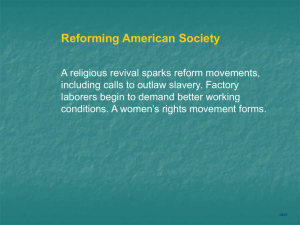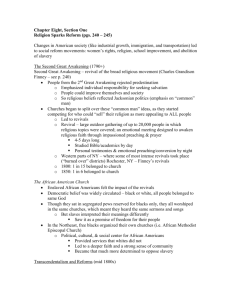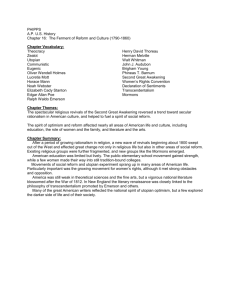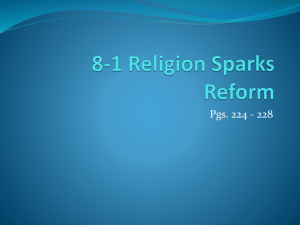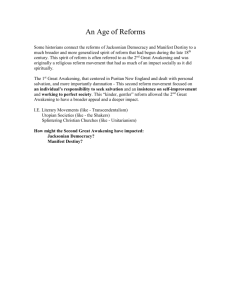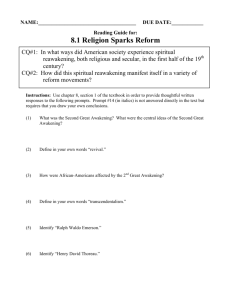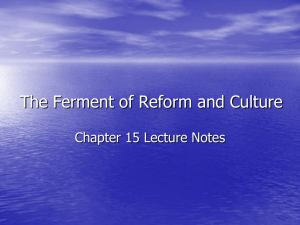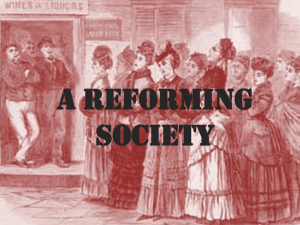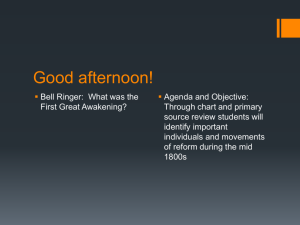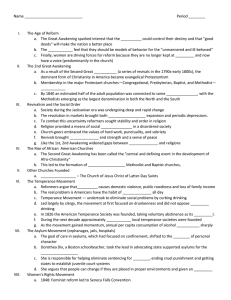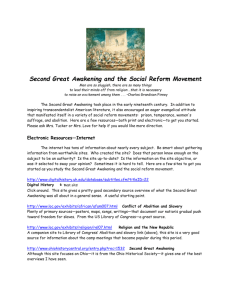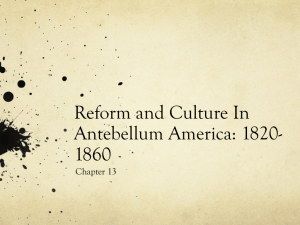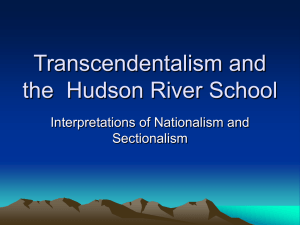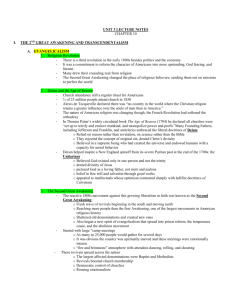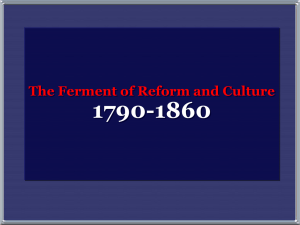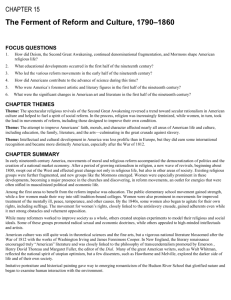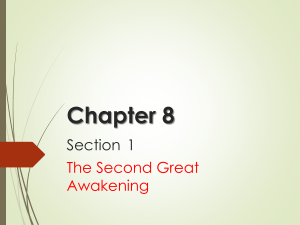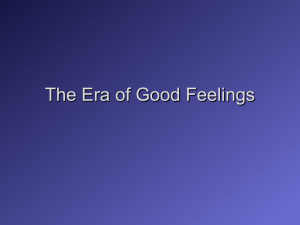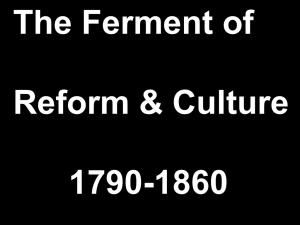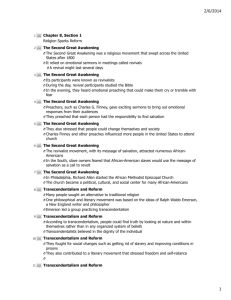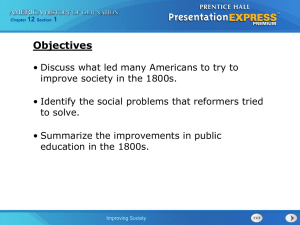Religion Sparks Reform
advertisement
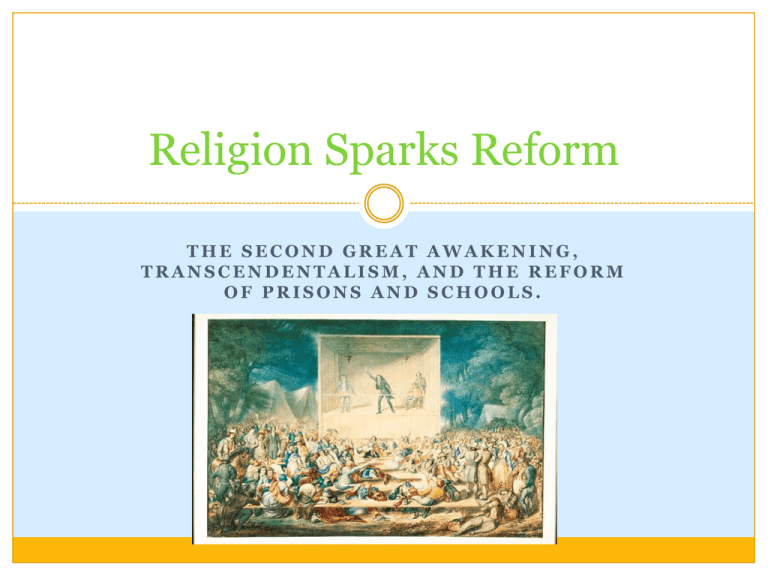
Religion Sparks Reform THE SECOND GREAT AWAKENING, TRANSCENDENTALISM, AND THE REFORM OF PRISONS AND SCHOOLS. The Second Great Awakening The Second Great Awakening was a large-scale religious movement in the early to mid-19th century that led to an upswing in church membership. This movement rejected the idea of predetermination and emphasized individual responsibility for seeking salvation. Large gatherings, or revivals, of 20,000 people would meet for days to hear the preaching of men such as Charles Grandison Finney. How was this idea of individualism and responsibility similar to the political times? The Jacksonian democracy promoted the power of the common citizen; an individual in society. The Black Second Great Awakening The Second Great Awakening brought Christianity to blacks, both free and enslaved, as well. In the South, blacks went to the same churches as whites, but were segregated into sections. In the Northeast, blacks had separate churches like Richard Allen’s Bethel African Church in PA. This church grew rapidly and became a political, cultural, and social center for blacks that would provide for its followers. Allen also held the 1st Black National Convention Transcendentalism Religion was not the only way in which reform ideals were expressed. Literature became an outlet for many to address the need for change in society. Ralph Waldo Emerson was a N.E. writer who led a group practicing Transcendentalism. This philosophical movement emphasized simplicity, natural truth, and emotion. Henry David Thoreau was a popular author of this movement and embodied the beliefs by abandoning society and living alone on the shores of Walden Pond for 2yrs. Thoreau believed in the importance of the individual conscience and urged people to not obey laws they considered unjust. What was the term for this, and who were some people who used these ideals later in history? Civil Disobedience Civil Disobedience was an act of peaceful protest used by famous people such as Martin Luther King Jr. and Mahatma Ghandi. Unitarianism Unlike the appeal to emotions found in both revivals and transcendental literature, the Unitarian beliefs emphasized reason and appeals to conscience. They agreed with revivalists that individual and social reform was possible and important to the good of mankind. William Ellery Channing, Unitarian Leader. Unlike revivals, the Unitarians believed that conversion was a gradual process and a long road to perfection. The torch, a symbol for the Unitarians. Utopian Communities The optimism of religious and social reform also led to the formation of Utopian communities. These communities strived for selfsufficiency and idealized harmony. Many of these “experiments” failed after a few years. Shaker Communities The Shakers were groups established in NY, N.E., and on the frontiers and followed the teachings of Ann Lee. Known for their songs which they would “shake” and dance to, they believed in equality and pacifism. What in the Shaker belief system ultimately led to them “dying” off over time? Shakers vowed to not marry or procreate upon converting, and therefore required converts and adoption to sustain their communities. In the 1840’s, their population was 6,000. By 1999, there were only 7 recorded Shakers in the U.S. Reforming Asylums & Prisons After a French writer harshly criticized the American prisons for their severe and rigid control of criminals. Dorothea Dix fought to reform the prison system when she discovered that the mentally ill were imprisoned in regular prisons, rather than being hospitalized. Dix wrote to the Massachusetts legislature, reporting her findings on the mentally ill. This led to several reforms over the next 7yrs, including southern states persuaded by Dix. Prisons began to aim towards rehabilitation… How did this embody the ideals of the awakening? “Hope for everyone,” was the idea of the time. Salvation could be earned, and no one was surely damned. Reforming Schools What did schools look like prior to the mid-19th century? Classrooms were not divided by grade and attendance was not mandatory. Many stopped going after the age of 10. There was also no uniform education policy throughout the nation. Demands for state-funded public school led to controversy from the wealthy, why? Horace Mann was the 1st secretary of the Mass Board of Ed in 1837, and through this position he established reforms such as curriculum changes, teacher training, and more money being spent on education. Conclusions The focus placed on individual responsibility in religion transitioned to societal reforms as more people felt personally responsible for making society better. Schools, prisons and communities felt the shockwaves of change as individuals tried to shape how the future should look. The issues of slavery, women’s roles, and the workplace would also become targets for reform REMINDERS HW: Ch. 8.2 DENotes (pp.248-253) Have a great day and leave the room better than you found it.
